Why Do Different Engine Configurations Make Different Sounds?
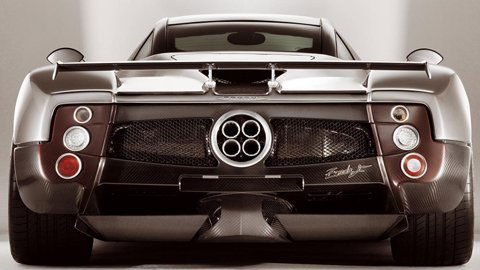
Everyone has their favourite engine configuration and the biggest weighting in this decision is normally given to the sound it produces. The template that tickles my fancy is a V10, simply due to the intense shriek emitted from automotive royalty like the Porsche Carrera GT and Lexus LFA. From a V12’s baritone howl to a four-banger’s raspy revving, it begs the question: why do different numbers of cylinders produce different engine noises?
Sound is based around air pressure and the interaction between the vibrations created by the pressure change and our ears. The pitch of a sound is down to the frequency of the sound wave that is produced, with the frequency being defined as the amount of times the sound wave oscillates in one second. Due to the sheer amount of moving components on a car – especially in the engine – hundreds of frequencies are produced by the car when running. However, only one main frequency makes its way from the engine to your ears as the predominant sound of the car in question and that is the root note.
An engine’s root note is created by the timing and pressure of the exhaust gases leaving the combustion chamber and into the manifold. Known as pulses, the exhaust gases are forced out of the cylinders by each exhaust stroke which sends the pulse of high pressure gas out through a valve to the exhaust manifold.
The rate that these pulses reach your ears is governed by the speed of the engine rotating. The faster the engine speed, the more exhaust strokes are performed therefore there is an increase in the rate of exhaust pulses. This is why an engine note increases in volume and pitch as revs increase. To differentiate between different engine configuration sounds, you have to look at the firing order.
For example, you may wonder why a Ferrari California’s V8 can idle smoothly and then can rise up to a screaming redline, but an old-school American muscle car like a Charger sits gargling and burbling and can seem to be running much rougher than the Italian car. This is down to a differing firing order within the engine due to a difference in configuration. The Ferrari uses what’s called a flat-plane crank, while the Charger has a cross-plane crank.

For the flat-plane, this means the cylinders fire one after another on opposing sides of the V-formation, so the exhaust pulses are balanced in terms of timing and formation as they travel down the exhaust manifold. The cross-plane engine is irregular in its firing order due to the connecting roads being ninety degrees to each other. It almost seems to fire in a random order at a glance, hopping all over the cylinder banks.
There are moments in the firing order that cause two exhaust pulses to be produced from the same side of the engine, thus creating an irregularity in the sequence and spacing of exhaust pulses. This then produces that guttural sound of an American V8 due to the bunching up and mixing of pulses, rather than the clean, even pulse rate of the Ferrari. The flat-plane crank in the Ferrari creates a whole tonne of vibration which is why it is much louder when revved. It is also much lighter than the cross-plane design as the American car needs balancing weights to keep the crankshaft in check. This lightness also contributes to the high revving nature of the Ferrari’s V8.
Different configurations of engines differ in sound due to the values of the dominant frequency emitted from each motor. To calculate this frequency, the engine speed has to be broken down from revolutions per minute to revolutions per second, which is simply dividing the RPM value by sixty.
This value must then be multiplied by the amount of cylinders fired for each revolution of the crankshaft, which in the V6-engined Honda NSX would be three or in a Golf R’s inline-four it would be two. Here’s a quick example calculation:
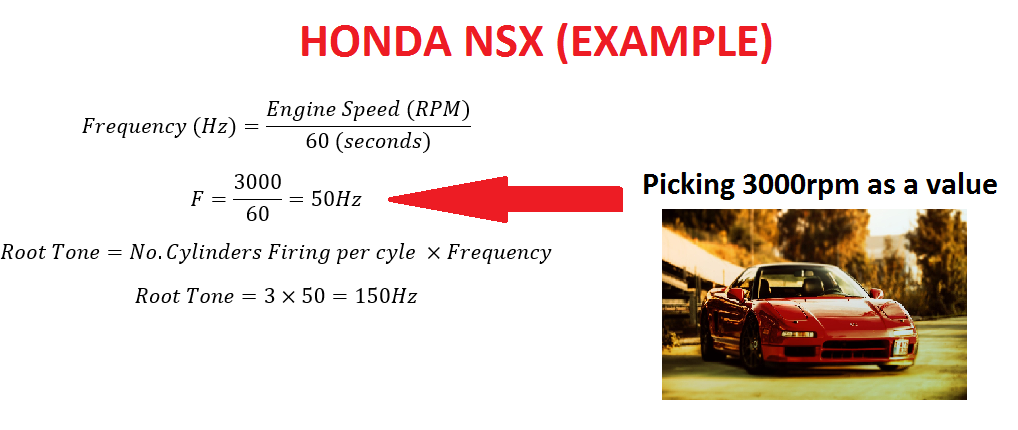
So in terms of the main backing sound of an engine, it is mostly down to the way in which the engine fires and also the multiple of cylinders that the engine has. Before any exhaust tuning or sound trickery, a V12 will have roughly the same tone of engine sound as a V6, an inline-five will have the same dominant tone as a V10 and so on. It is only after the other frequencies from the lesser dominant moving parts of the engine combine with the root frequency that an engine note can be distinguished and assigned to a certain car. This therefore differentiates engines like the NSX’s V6 compared to the KV6 in the MG ZS, with other ancillary components contributing to each car’s output tone.
Another factor to mix in to the sound that we hear is exhaust tuning. Whole teams of engineers in the NVH (Noise, Vibration and Harshness) sectors of a company will research the impact of different exhaust pipe diameters and constrictions to enhance or cancel out certain frequencies. Each pressure change from constricting and expanding the exhaust system will result in altered frequencies being emitted from the tailpipes.
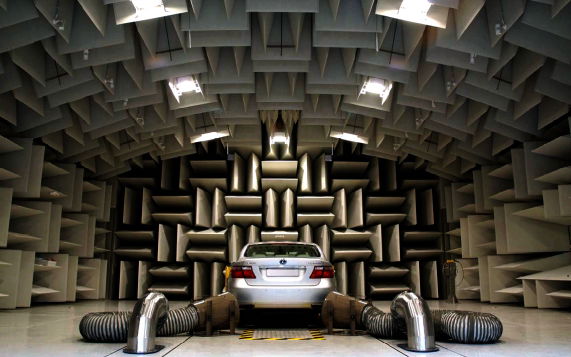
Big bore exhausts for example reduce the exit pressure of the exhaust gases, creating a low frequency, deep rumble that normally hasn’t had a chance to quieten down in a silencer.
Car manufacturers are pretty serious about noise, too. Millions of pounds are invested into constructing large noise-cancelling chambers that a car can sit in. This allows the engineers to pick out the exact frequencies that they wish to tune to result in the precise exhaust tone that the customer would be looking for. Who can blame the manufacturers spending that much money when the engineers can come up with symphonies like the Ferrari 458, Audi R8 and Lamborghini Aventador?
Although all the fine-tuning performed on new cars these days may seem to detract from the raw nature of the car, I think we should very much praise the manufacturers that leave the exhaust tone at least down to mechanical processes like a slightly modified exhaust. Now that companies like BMW are synthesising engine noise into the cabin to simulate bigger engine configurations, some respect should be given to the engineers that still make their engines sing the old-fashioned way. And with downsizing now rife in the performance car industry, I recommend you listen to some classic V8s to put your faith back into humanity. I recommend a Lola T70.
Do you think you know your ricer inline-fours from your monstours Bentley W12s? Take this test to find out!
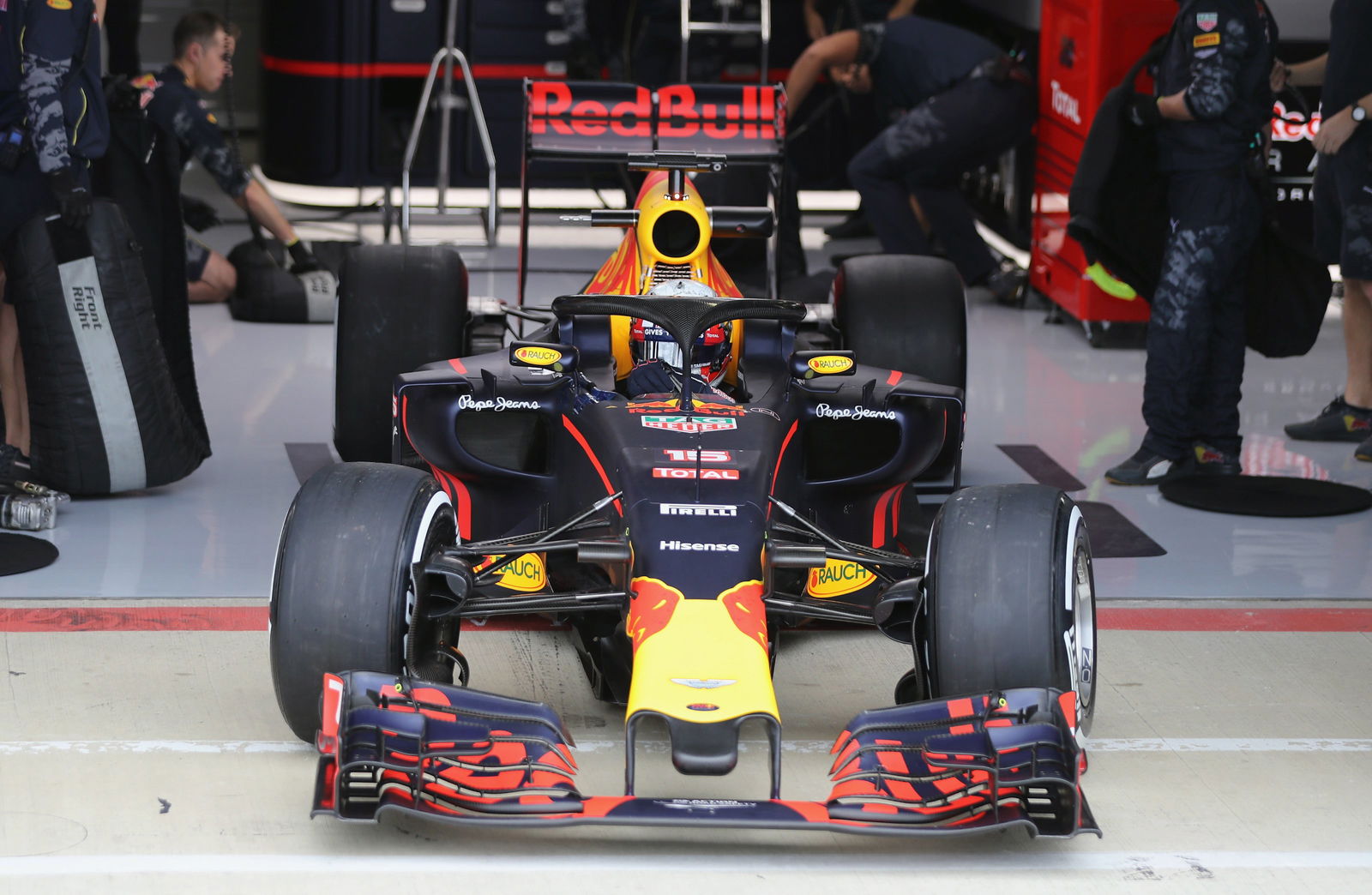
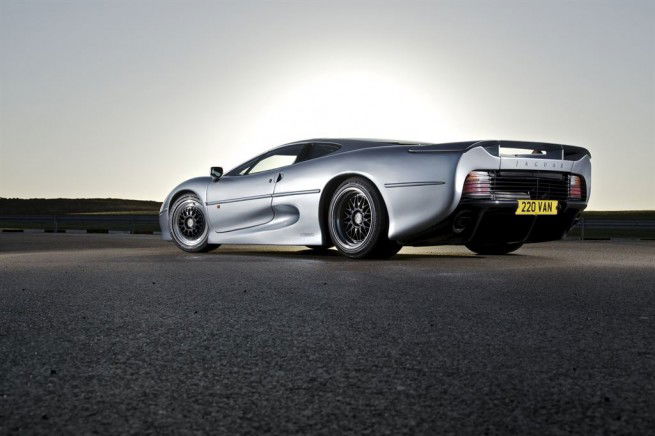
Comments
Still, why does the LFA V10 sound different from the M5 V10?
I like V6 the most __
Everyones here forget about the rotary engine or is it just me ??
That may be a stupid question, but why future cars like new RS3 or A45 have a tendency to POP a lot when let of the gas? What is the explanation of that ?
Then why do zoomies on old Hot Rods sound like V8’s without a common manifold?
There are some quirky engines like a Volvo 5 Cylinder that bend the rules slightly. The firing order greatly resembles a one sided V10 and the exhaust note straight-piped (which is un-godly btw) resembles it a bit too.
Michael Fernie , In your picture of a crank, your caption should be “GT350” not “GT500” :)
THAT R8 DOE
i watched that R8 video like 11 times
Any tuners car:
BRAAAAAAAAAAAPPPPPPPPPPP STTUTUUUTUTUTUUTUTUTUTU
BRAAAAAAAAAAAAAAAAAAAAAAAAAAAAAAAPPPPAPAPAPAPAPPAP STUSTUSTUSTUSTU
BRAAAAAAAAAAAPPPPPPPPPPP STTUTUUUTUTUTUUTUTUTUTU
BRAAAAAAAAAAAAAAAAAAAAAAAAAAAAAAAPPPPAPAPAPAPAPPAP STUSTUSTUSTUSTU
BRAAAAAAAAAAAPPPPPPPPPPP STTUTUUUTUTUTUUTUTUTUTU
BRAAAAAAAAAAAAAAAAAAAAAAAAAAAAAAAPPPPAPAPAPAPAPPAP STUSTUSTUSTUSTU
BRAAAAAAAAAAAPPPPPPPPPPP STTUTUUUTUTUTUUTUTUTUTU
BRAAAAAAAAAAAAAAAAAAAAAAAAAAAAAAAPPPPAPAPAPAPAPPAP STUSTUSTUSTUSTU
BRAAAAAAAAAAAPPPPPPPPPPP STTUTUUUTUTUTUUTUTUTUTU
BRAAAAAAAAAAAAAAAAAAAAAAAAAAAAAAAPPPPAPAPAPAPAPPAP STUSTUSTUSTUSTU
Pagination